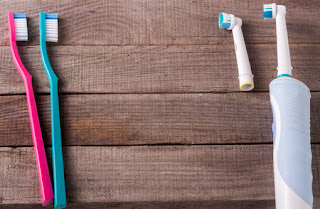Last week's Blogpost covered a very interesting subject; i.e THE HISTORY OF TOOTHBRUSHING.
And I would like to build on that topic by discussing the different types of toothbrushes currently on the market.
So in today's Blogpost, I will answer all of your questions about the best toothbrush for your teeth, review each type of toothbrush and go over its pros and cons.
In January 2003, the toothbrush was selected as the number one invention Americans could not live without.
To encourage good dental hygiene and to help you make sure that you're using a new, effective brush that hasn't been worn down or matted with use, most dentists give their patients new toothbrushes at every cleaning.
However, is the toothbrush your dentist gave you really the best for your dental and oral health needs? How can you tell which brush is right for you?
TYPES OF TOOTHBRUSHES
Manufacturers have come up with many different types of toothbrushes. There are two broad classifications of toothbrushes: manual and elecric.
Before you even get to electric toothbrushes, the manual ones will offer you very many types.
Before you even get to electric toothbrushes, the manual ones will offer you very many types.
MANUAL TOOTHBRUSHES
Manual toothbrushes are operated by hand.
Classifications of manual brushes are based on:
- Hardness - The hardness of the bristles varies, and this is very important to check when buying a toothbrush. Soft: For most people, a soft toothbrush is recommended since it is easier on the gums and teeth.Medium: Medium types are good enough for people with average dental conditions.Hard: Hard bristle toothbrushes are quite difficult to find on the market now because of the increasing preference for softer alternatives. The hard bristles are likely to cause gum recession, lesions, and bleeding, depending on how much force you use when cleaning your teeth.
- Shape of head -Toothbrush heads can either be conventional or diamond shaped. DIAMOND-SHAPEDDiamond shaped toothbrushes have narrow tips. This shape allows the bristles to get to the back and sides of your molars. ------------------------------ CONVENTIONAL-SHAPED
Conventional toothbrush heads are larger than diamond shaped brushes. Very large heads could pose a challenge when cleaning the molars and premolars.
- Bristle Pattern -Dental associations have set standards for the design of toothbrush bristles. For example, the bristles can't be made with sharp edges. The bristles should also not fall off under normal use.
- Handle design -Handles for toothbrushes vary from basic to quite complex designs. Manufacturers are free to come up with creative handle design. Choosing the design should mostly be based on whatever you find convenient and comfortable. The handle should be thin enough to fit into your mouth and in your hand.
There is much more information about toothbrushes that you may find useful.
However, that is what I will leave you with for today. And in my next Blogpost, I talk more about the other types of toothbrushes that are on the market.
TIP: It is important to change your toothbrush after every three months for proper dental
health. In case the bristles begin to show signs of wear and tear before the three
months, you should replace the toothbrush sooner. You can try different shapes and
sizes to find a brush feel that most comfortable in your mouth.








No comments:
Post a Comment
Comment on this. And submit.